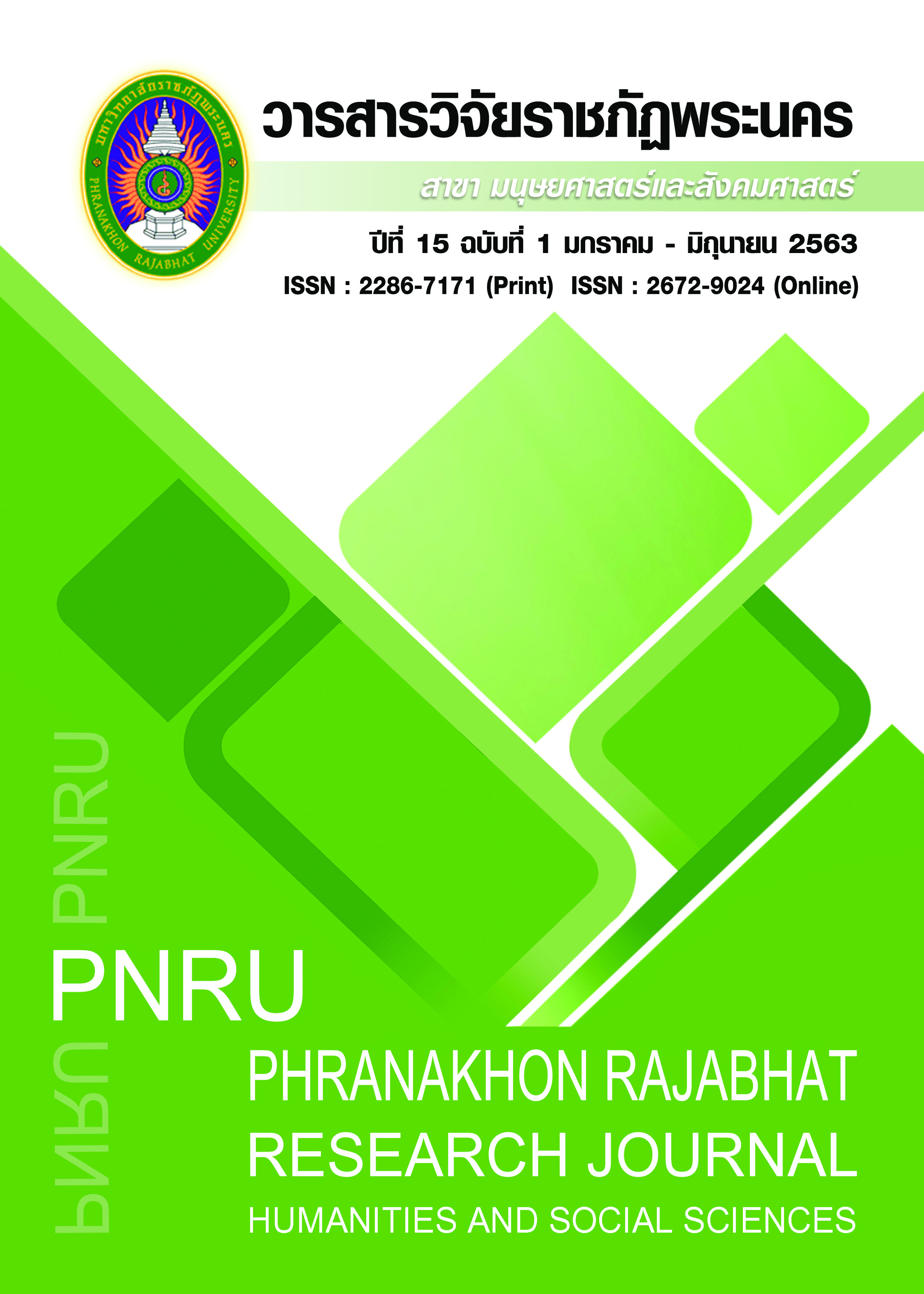INCREASE OF THE EFFICIENCY OF WAREHOUSE MANAGEMENT, THAI DESSERT COMMUNITY ENTERPRISE GROUP, NAKHON NAYOK PROVINCE
Main Article Content
Abstract
The objectives of this study were to: 1) Analyze the current issue of warehouse management of Thai Dessert Community Enterprise Group, Nakhon Nayok Province, 2) Arrange the supportive information and to develop the current warehouse system of Thai Dessert Community Enterprise Group, and 3) Evaluate the efficiency of the new warehouse management for Thai Dessert Community Enterprise Group, Nakhon Nayok Province. The key informants were 10 representatives from the Thai Dessert Community Enterprise Group, Nakhon Nayok Province.The research tools were the observation and in-depth interview techniques. The information gathering was divided into 3 stages. The first stage was the analysis of the issue of the warehouse. The second stage was the information gathering and the development of the warehouse system. The third stage is the evaluation of the efficiency of the warehouse. The information gathered was analyzed using Microsoft Excel. Lean thinking approach and ABC Analysis were applied to the analysis in this research. The result of the research has shown that the overall processes of the warehouse before the improvement required 34.04 minutes on average. Post improvement required 17.04 minutes. The products in the A group scored 17.50% out of the list while the B group products scored 32.50% out of the list. The products in the C group scored 50% out of the listed products respectively.
Article Details
Each publish articles were copyright by Phranakorn Rajabhat University
Any contents which appeared in each articles in the journal were authors personal opinion. It did not relate to Phranakorn Rajabhat University and other instructors in the university. Each authors would take responsibility on their articles. If there are any mistake, the authors will take responsibility themselves
References
Achanga, P., Shehab E., Roy R. & Nelder G. (2006). Critical Success Factors for Lean Implementation within SMEs. Journal of Manufacturing Technology Management. 17(4), 460-471.
Afonso, H. & Cabrita, M.R. (2015). Developing a lean supply chain performance framework in a SME: a perspective based on the balanced scorecard. Procedia Engineering. 131, 270 – 279.
Almeida, A. & Cunha, J. (2017). The implementation of an Activity-Based Costing (ABC) system in a manufacturing company. Procedia Manufacturing. 13, 932-939.
Basin, W.M. (1990). A Technique of Applying EOQ Model to Retail Cycle Stock Inventories. Journal of Small Business Management. 28(1), 48-55.
Braglia, M., Grassi, A. & Montanari, R. (2004). Multi-attribute classification method for spare parts inventory management. Journal of Quality in Maintenance Engineering. 10(1), 55-65.
Bouazza, A.B., Ardjouman, D. & Abada, O. (2015). Establishing the Factors Affecting the Growth of Small and Medium-sized Enterprises in Algeria. American International Journal of Social Science. 4(2), 101–115.
Bortot, P., Coles, S.G. & Sisson, S.A. (2007). Inference for stereological extremes. J. Am. Stat. Assoc. 102, 84–92
Grelaud, A., Robert, C.P. & Marin, J.M. (2009). ABC methods for model choice in Gibbs random fields. Comptes Rendus Mathematique. 347, 205–210.
James, A.T. & Jerry, D.S. (1998). The Warehouse Management Handbook. The second edition. North Carolina: Tompkins press.
Kolla S., Minufekr M. & Plapper P. (2019). Deriving essential components of lean and industry 4.0 assessment model for manufacturing SMEs. Procedia CIRP. 81, 753-758.
Lopes, J.S. & Boessenkool, S. (2009). The use of approximate Bayesian computation in conservation genetics and its application in a case study on yellow-eyed penguins. Conservation Genetics. 11(2), 421–433
Mehdizadeh, M. (n.d.). Integrating ABC analysis and rough set theory to control the inventories of distributor in the supply chain of auto spare parts. Computers & Industrial Engineering. Retrieved August 30, 2019, from https://www.sciencedirect.com/science/ article/pii/S036083521930052X
Meyer, H. (1991). An eight-step approach to inventory accuracy: a case study at Leviton manufacturing company. Production and Inventory Management Journal. 32(2), 40-2.
Muchaendepi, W., Mbohwa, C., Hamandishe, T. & Kanyepe, J. (2019). Inventory Management and Performance of SMEs in the Manufacturing Sector of Harare. Procedia Manufacturing. 33, 454-461.
National statistical office. (2018). The 2017 Food Consumption Behavior Survey. Bangkok: Statistical Forecasting Division, National statistical office. (in Thai)
Phranakhon Rajabhat University. (2017). New 20-year Rajabhat University’s strategy (2017-2036). Retrieved November 5, 2018, from http://www.wpm.ac.th/file/yudtasart.pdf. (in Thai)
Pritchard, J.K., Seielstad, M.T., Perez-Lezaun, A. & Feldman, M.W. (1999). Population growth of human Y chromosomes: a study of Y chromosome microsatellites. Mol. Biol. Evol. 16, 1791–1798.
Ratmann O., Jørgensen O., Hinkley T., Stumpf M.P., Richardson S. & Wiuf C. (2007). Using likelihood-free inference to compare evolutionary dynamics of the protein networks of H pylori and P. falciparum. PLOS Comput Biol. Retrieved August 24, 2019, from https://journals.plos.org/ploscompbiol/article?id=10.1371/journal.pcbi.0030230.
Ramkhamhaeng University. (2004). Thai desserts: Auspicious snack. Ramkhamhaeng News Journal. 33(47), 4. (in Thai)
Redeker, G.A., Kessler, G.Z. & Kipper, L.M. (2019). Lean information for lean communication: Analysis of concepts, tools, references, and terms. International Journal of Information Management. 47, 31-43.
Rose, A. M. N., Deros, B. Md., Rahman, M. N. Ab. & Nordin, N. (2011). Lean manufacturing best practices in SMEs, Proceedings of the 2011 International Conference on Industrial Engineering and Operations Management Kuala Lumpur, Malaysia, 22 – 24 January 2011. 872 –877
Thakkar J., Kanda A. & Deshmukh S.G. (2012). Supply chain issues in Indian manufacturing SMEs: Insights from six case studies. Journal of Manufacturing Technology Management. 23(5), 634 – 664.


